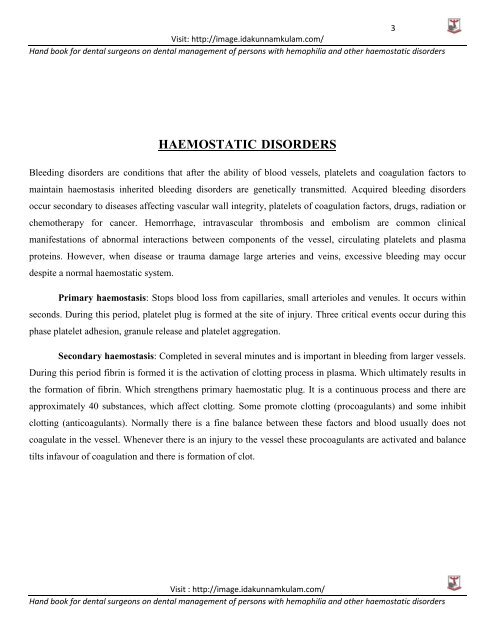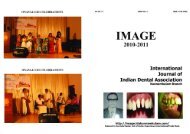hand book for dental surgeons - Indian Dental Association ...
hand book for dental surgeons - Indian Dental Association ...
hand book for dental surgeons - Indian Dental Association ...
You also want an ePaper? Increase the reach of your titles
YUMPU automatically turns print PDFs into web optimized ePapers that Google loves.
3<br />
Visit: http://image.idakunnamkulam.com/<br />
Hand <strong>book</strong> <strong>for</strong> <strong>dental</strong> <strong>surgeons</strong> on <strong>dental</strong> management of persons with hemophilia and other haemostatic disorders<br />
HAEMOSTATIC DISORDERS<br />
Bleeding disorders are conditions that after the ability of blood vessels, platelets and coagulation factors to<br />
maintain haemostasis inherited bleeding disorders are genetically transmitted. Acquired bleeding disorders<br />
occur secondary to diseases affecting vascular wall integrity, platelets of coagulation factors, drugs, radiation or<br />
chemotherapy <strong>for</strong> cancer. Hemorrhage, intravascular thrombosis and embolism are common clinical<br />
manifestations of abnormal interactions between components of the vessel, circulating platelets and plasma<br />
proteins. However, when disease or trauma damage large arteries and veins, excessive bleeding may occur<br />
despite a normal haemostatic system.<br />
Primary haemostasis: Stops blood loss from capillaries, small arterioles and venules. It occurs within<br />
seconds. During this period, platelet plug is <strong>for</strong>med at the site of injury. Three critical events occur during this<br />
phase platelet adhesion, granule release and platelet aggregation.<br />
Secondary haemostasis: Completed in several minutes and is important in bleeding from larger vessels.<br />
During this period fibrin is <strong>for</strong>med it is the activation of clotting process in plasma. Which ultimately results in<br />
the <strong>for</strong>mation of fibrin. Which strengthens primary haemostatic plug. It is a continuous process and there are<br />
approximately 40 substances, which affect clotting. Some promote clotting (procoagulants) and some inhibit<br />
clotting (anticoagulants). Normally there is a fine balance between these factors and blood usually does not<br />
coagulate in the vessel. Whenever there is an injury to the vessel these procoagulants are activated and balance<br />
tilts infavour of coagulation and there is <strong>for</strong>mation of clot.<br />
Visit : http://image.idakunnamkulam.com/<br />
Hand <strong>book</strong> <strong>for</strong> <strong>dental</strong> <strong>surgeons</strong> on <strong>dental</strong> management of persons with hemophilia and other haemostatic disorders



